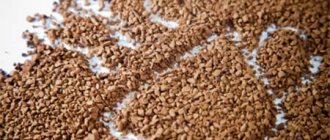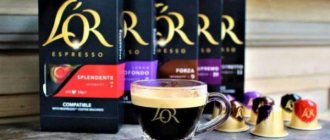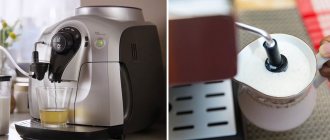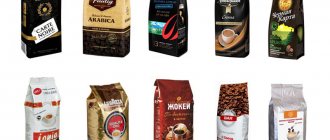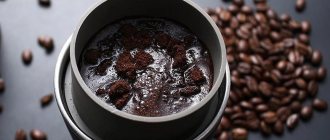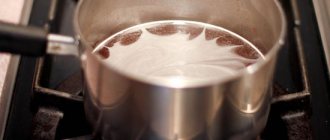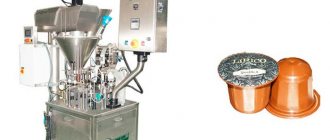On store shelves you can find many varieties of instant coffee: powdered, granulated, and freeze-dried. True “coffee lovers” certainly prefer to buy natural beans or ground coffee. But it also happens that there is no time or opportunity to brew a cup of natural aromatic drink.
This is where instant coffee comes to the rescue. The freeze-dried drink is considered the highest quality and most expensive of all its varieties. So what is freeze-dried coffee, and how is it different from granulated or powdered coffee?
Features of freeze-dried coffee
The difference between sublimate and other types of instant coffee is the use of advanced processing technology. This technique is called freeze dried, which means “freeze drying”.
Freeze-dried coffee differs from granulated coffee in appearance. The light brown particles are shaped like fragments of a thin layer or pyramid. In appearance, the granules seem very dense and hard, but under the influence of boiling water they dissolve quickly and evenly. Sublimate is of better quality, and therefore more expensive than other types of coffee.
Who should abstain
Coffee in excessive doses is still harmful. In everything you need to know when to stop. This rule applies here too. Even a healthy person who drinks too much will feel nausea, increased blood pressure, increased heart rate and loss of sleep.
If you simply drink freeze-dried coffee for breakfast in the morning, this will lead to ulcers or gastritis. The reason is that manufacturers add various flavors and enhancers to the composition, which leads to irritation of the intestinal and stomach mucosa. It is also not recommended to take coffee during pregnancy. It has an adverse effect on the fetus and causes a risk of premature birth.
You don’t need to think that only inexpensive varieties contain artificial elements. Brands do not describe the composition on the packaging in too much detail, so even there there is some chemistry.
From the history
The very possibility of sublimating substances was discovered in 1906. The authorship of the discovery belongs to the French biophysicist Jacques-Arsene D'Arsnoval. Research has shown that cooling and low pressure cause moisture to evaporate quickly. Under vacuum conditions, the liquid disappears almost instantly. And, as usual, the scientific discovery immediately found application in the army.
Only in the post-war years did they decide to apply innovative technology in the food sector. American researchers have determined that freezing allows products to retain the maximum beneficial composition. This was followed by many years of experiments by Nestle to introduce know-how into the coffee industry.
Experiments on sublimation of coffee were crowned with success only in 1965. This is how the first can of Nescafe Gold was released. All coffee factories were in a hurry to adopt the innovation. At the end of the 80s, almost half of the world's coffee volume was already produced by sublimation.
Excursion to production
From the receipt of raw materials to the factory to the packaging of the finished product, a long, painstaking process occurs. The initial stage is no different from the production of granules and powder. Raw coffee beans are roasted and very finely ground. The powder is then poured with hot water to obtain a concentrate. In sealed containers, the intermediate product is thoroughly boiled for 2-3 hours. Using steam extraction equipment, coffee oil is extracted from the raw material.
At the next stage, freeze-dried coffee is made directly. The grounds are placed in a column with a powerful freezer. To preserve its properties, the concentrate must be frozen instantly. Subsequently, exposure to vacuum quickly removes moisture from the crystals. Next, the technique crushes uneven pieces, achieving the desired shapes and sizes. Now the previously extracted oil is added to the granules for taste and aroma.
When sublimating, as a rule, chemical enhancers of smell and taste are not used. This is not necessary due to the processing features.
How it's done:
- only green grains are taken;
- they are fried;
- immersed in large industrial vats;
- pour liquid and cook for several hours;
- the resulting condensate is removed to act as a natural flavoring agent;
- the cooked element is quickly frozen;
- drying takes place in vacuum chambers.
Next, the product is crushed until golden granules are formed. To obtain a certain taste or aroma, the extract is seasoned at the last stage. They can be artificial and natural. All that remains is to package the finished powder into packages.
Comparison with other types of instant coffee
The difference between simple instant and freeze-dried coffee is mainly in processing technology. Just like fruits and vegetables, coffee concentrate retains its aroma, taste and beneficial properties well when frozen. Therefore, to produce expensive brands, factories purchase selected Arabica beans.
Some manufacturers of powder and granules indicate the use of elite grains as raw materials. This is nothing more than a publicity stunt. Instant budget drinks are made from sorted “substandard” drinks.
Low-quality raw materials are only one drawback of the composition of inexpensive coffee. Even more important is the presence of flavorings, stabilizers, dyes and flavor enhancers in powdered and granulated drinks. The grain loses its properties on the conveyor, and they need to be replaced. Chemical additives are not safe for health.
- Don't miss: What is the difference between instant and ground coffee
Definitely, freeze-dried coffee is better than granulated and powdered coffee. Freeze dried processing allows the instant product to be as close to natural as possible.
Production of granulated coffee
The initial manufacturing steps are similar to the sublimation process.
The following processing distinguishes granulated coffee from freeze-dried coffee. The finished boiled extract is sprayed in a stream of hot air until the moisture is completely removed. To obtain granules, the mass is cooled and mixed with aromatic, flavoring, structure-stabilizing and other additives. As a result, a powder is formed, which is presented in the usual powdered version of coffee. The production of a granular product involves further processing of the prepared powder with steam. When moisture hits the mass, it is absorbed by the dry substance and granules are formed. Depending on the quality and brand of the product, the appearance may vary, but it does not look at all like freeze-dried coffee.
It is important to understand that when making any soluble product, the outer shell of the grain, which contains caffeine, is removed, which is used in pharmacology and the food industry. The inner part contains almost no this alkaloid, so essentially any instant product is decaffeinated coffee. As a result, the drink does not have an invigorating effect; on the contrary, it may make you want to sleep.
On a note! Sometimes additional caffeine is added to the instant product for strength, since almost no caffeine remains during processing of the beans.
Benefits and harms
The real benefits are found only in natural fruits. But freeze drying makes it possible to preserve at least a small fraction of the unique composition of the grains. Some vitamins and microelements do not have time to evaporate on the factory line. The sublimate contains a small dose of vitamins PP and B2, iron, phosphorus, calcium, sodium.
This composition has a beneficial effect on brain function, digestive organs, and the strength of bone tissue. The caffeine content is optimal for raising tone and stimulating brain activity. A cup of freeze-dried coffee will instantly provide energy and improve your mood.
Main stages of manufacturing
Probably, each of us will be interested to know how our favorite coffee is made. This process is quite expensive and labor-intensive.
First, the coffee beans are roasted and ground. Then the finished powder is boiled for three hours in separate closed containers.
One of the important stages of processing is the extraction of essential oils from the product. A special tube attached to each container carries out oils that will be required for further use.
Then, the coffee mass is frozen. This step is carried out very quickly at low temperatures because it affects the quality of the original product. With this kind of vacuum freezing, when the moisture evaporates quickly, the coffee mixture dries out completely.
The next step is to grind the dry solid mass into small pieces; these are the coffee granules that we see in the pack.
Which to choose
When you come to the store to buy a freeze dried product for the first time, you should consider the following points:
- the best storage conditions are an airtight glass jar;
- the mark “100% freeze-dried coffee” is a good sign;
- if the granules are visually the same size, this is a quality product;
- foreign impurities and powdery debris at the bottom of the jar are a compelling argument to pass by;
- Coffee also has an expiration date. And the shorter it is, the fewer harmful additives it contains.
Expensive drinks are made only from the Arabica variety. Such granules dissolve better, have no sediment, and are much tastier. And the caffeine content in Arabica is significantly lower than in the budget Robusta.
- Read more: Which is stronger, Arabica or Robusta
Manufacturer is one of the main selection criteria. If your personal “favorite” has not yet been determined, you can look for it in the ranking of the best freeze-dried coffee brands. Critics' opinions and consumer preferences overlap in several world-famous brands: Egoiste, Bushido, Taster's Choice, Arabica, Carte Noire. This is the best that the frozen pellet market offers.
Rating of the best brands
From a huge number of names and manufacturers of freeze-dried coffee, it is not easy to choose the best product. The Test Purchase program compiled a rating of the most popular brands of this drink.
This list included:
- Bushido is the highest quality, but very expensive, freeze-dried dark roast coffee. It has a natural bitter taste and strong aroma. Does not dissolve in cold water. We wrote separately about Bushido coffee from Japan here.
- Carte Noire is a wonderful French coffee, with a balanced, pleasant taste, but it is not cheap. The granules dissolve well even in ice water. We reviewed the range of Carte Noire coffees in this article.
- Tchibo Exclusive previously belonged to the premium price category, but recently manufacturers have reduced its cost. Oddly enough, the price reduction had no effect on the quality of the product.
- Moccona does not have a rich taste, but it is much cheaper than expensive premium brands. Dissolves in cold water.
- Nescafe is the cheapest freeze-dried coffee that does not have an expressive taste, but with a strong and bright aroma.
Did you know that not only tea is made from hibiscus leaves, but it is also used in confectionery, jams, jellies, etc. Read more about hibiscus tea: beneficial properties, contraindications, brewing recipes at the link.
Have you tried the so-called “long” espresso? You can get acquainted with this type of coffee - lungo coffee here.
In our next article we will talk about perhaps the most famous oolong tea - Chinese Tiguanyin tea: its amazing effect, properties, varieties and much more:
